|
|
Celestron CPC Deluxe Edge
1100HD Optical Analysis
Wade Van Arsdale
Little Rock, AR., USA
November 5th, 2011
|
|
(Shown above with AstroZap Aluminum Dewshield)
Synopsis:
This round of tests used an initial front-fan cooldown of 30 minutes through the Fastar cell with a Starizona CoolEdge high-CFM filtered fan. There is a significant and consistent improvement in image stabilization seen visually and with the webcam during star testing when using a front-fan prior to beginning observing or imaging. Internal felt flocking was also added to see if the initial thermal equilibrium gained from the front fan could be *maintained* for a longer period. It is inconclusive at this point how much affect the flocking is having on insulating the OTA and slowing down regeneration of internal tube thermals, but some improvement in this regard is being seen with the flocking present.
I. Factory Build and Assembly Errors:
During
the initial Roddier tests to establish the baseline performance levels for the
OTA in its original factory condition, unfortunately it was discovered that this
unit had gross mis-assembly errors that were significantly degrading its
performance. The best this OTA could do on repeated Roddier tests was only
0.87 Strehl with the central obstruction *not* included in the Strehl
calculations. The OTA also showed larger than normal amounts of spherical aberration and
coma, along with soft focus during visual use. Inspection and testing of
the optical components revealed the following factory build and assembly errors
were present:
1) Secondary mirror and Fastar assembly were mis-rotated in relation to
the OTA. There wasn't the usual orthogonal collimation screw pointing to
the top of the OTA for easy collimation. The Fastar assembly was mis-rotated
by approximately 40 degrees clockwise from the normal factory position.
2) The corrector, while etched and positioned at the normal 3 o'clock position, was also mis-rotated and not at the optimized position in relation to the primary mirror. The corrector was evidently mis-etched at the wrong position, which probably explains why the secondary mirror was also mis-rotated. This was a source of additional spherical aberration that was seen in the initial Roddier tests.
3) An abnormal optical overcorrection was found on the initial Roddier tests. The scope's optics were optimized in the Orange-Yellow wavelengths, and not the standard Green which is best for standard visual and imaging use. The optics were slightly overcorrected in Green, and worse overcorrected in Blue. This overcorrection is a much bigger problem than slight UNDER-correction because as the glass cools through the night, overcorrection only gets worse. This could lead to a worsening, softer focus on very cold nights with fast-dropping temps.
4) A significant secondary mirror decentering error of 2mm off-center one direction (4mm total PTV) in relation to the primary mirror was found. This was a source of the coma that was discovered in the initial Roddier tests even after carefully collimating the telescope.
Repairs and Realignment of
Optics:
1)
Using the Hotech
Advanced CT Laser Kit, the secondary decentering error noted above was
corrected.
2)
A series of repeated corrector rotation tests was conducted by rotating the
corrector 10 degrees per test, with Roddier testing run on each position to
determine the rotational position that gave the lowest spherical aberration,
least overcorrection, and best Strehl test in the Roddier analysis.
Eventually, after approximately 20 test and rotational cycles, the optimum
corrector rotational position was found. This position was approximately 35 degrees counterclockwise from the original 3 o'clock factory position of the
corrector glass.
Conclusions Regarding the Factory Condition of the Telescope Optics:
Of
the nine Celestron telescopes I've owned and numerous others I've inspected and
tested for fellow amateur astronomers over the past few years, this is the first
time I have encountered one with the gross build and assembly errors that this
new CPC EdgeHD fork mount model showed. Based on years of experience
with Celestron telescopes, in my opinion, this type of occurrence is a
rarity. One contributing factor could have been the fact that I ordered one
of their first-built units in a newly designed model that had just gone into
production. After filing a full report with data included to
Celestron Technical Support, they showed the hoped-for interest in this
situation. At current writing, Celestron is doing a serial number trace on
the telescope in an attempt to track down exactly what went wrong during the
factory build of this unit, and how it went wrong.
II. Goals of OTA
Testing:
Objectives:
1) Determine
the optical quality of a new Celestron CPC Deluxe EdgeHD-1100 after optimizing
the optical positioning and alignment of the various glass elements of the
telescope
2) Determine the effectiveness of felt flocking on the inside of the OTA
in improving the thermal stability of the telescope
3) Determine the effectiveness of a Starizona CoolEdge front fan at
bringing the tube into rapid thermal equilibrium prior to observing
Problem: The aluminum tube cools much faster than the OTA glass. It was determined through repeated visual, webcam, and Roddier testing that this severe imbalance in cooling efficiency between the two materials creates thermal air currents and boundary layers *inside* the OTA that degrade the wavefront quality similar to poor atmospheric seeing conditions. Using front-fan forced cooling of the OTA prior to testing consistently brought the OTA to thermal equilibrium and significantly stabilized the star-test patterns. But unfortunately, it was found that these thermals and boundary layers on the front side of the primary mirror glass and up the baffle tube would regenerate to a point that planetary performance was seriously degraded within approximately 15-20 minutes after the front fan was removed and secondary mirror was reinserted back into the OTA. So a way was needed to lessen the difference in cooling rates between the aluminum tube surface and primary mirror glass so the thermals and boundary layers could be lessened and wavefront quality improved.
Thermal Fixes Used for
This Test Cycle:
A combination of three remedies was used:
1) Felt
flocking from
Protostar was applied inside the entire OTA surface. This flocking was
used as a way to help insulate the inside aluminum tube surface and slow down
its cooling rate to more closely match the cooling rate of the mirror
glass. It was hoped that this would lessen the
amount of internal thermals and boundary layer regeneration inside the OTA after
initial thermal equilibrium was reached with the temporary front fan.
**NOTE**: removing the front corrector glass to install flocking may void
your factory warranty from Celestron. **DO NOT** attempt this modification
unless you have weighed the ramifications and are willing to take the warranty
risks and you have also carefully considered the risks of breaking the front
corrector glass or being unable to return the OTA to its original collimation
and corrector positioning on the front cell.
2) A Starizona CoolEdge high-CFM filtered front fan assembly was used in the Fastar housing for 30 minutes prior to running the Roddier tests. Since the OTA cannot be used while the front fan is in place, this is only a temporary fan that is used to bring about *initial* OTA equilibrium.
3) An AstroZap rigid aluminum, felt-lined dewshield. This part, along with retarding dew formation on the corrector glass, helps slow down over-cooling of the corrector and slows down tube thermal regeneration.
**Still to come**: A semi-permanent, "constant-on" rear fan solution from DeepSpaceProducts.com is currently under evaluation and may be available in the near future. This rear fan solution, when combined with either an internal or external OTA insulating material (either the internal felt flocking mentioned above or an external foam wrap) could potentially make the OTA remain stable for longer periods of time after initial front fan cool-down.
III. Strehl Test and Roddier Analysis
Test Date: November 5th, 2011
OTA Tested: 2011 Celestron CPC Deluxe Edge 1100HD
Test Sequence (after the initially discovered factory mis-alignment of the
optics was repaired):
1) Remove front corrector glass and install felt flocking internally.
3) Re-install corrector and re-collimate using on-screen webcam display of
the star-test pattern.
4) Remove secondary mirror and install temporary Starizona CoolEdge front fan into Fastar
cell for initial OTA cooling.
5) Run temporary front fan for 30 minutes prior to beginning test imaging.
6) Remove temporary front fan, reinsert secondary mirror back into Fastar cell, and begin imaging.
Test Site: C.A.A.S. East Observatory, Little Rock, AR., el. 650 ft.
Software used for the analysis: WinRoddier English Ver. 2.2, posted to the
Roddier user group by Mark Crossley
Skies: Clear
Seeing: 7 out of 10
Transparency: 8 out of 10
Temperature: 56 degrees F, dropping to 54 degrees F during OTA testing
Dewpoint: 48 degrees
Wind: S, 5 mph
Test camera: Lumenera SKYnyx 2-2C webcam with Baader IR/UV cutoff filter @
640 x 480 image size, 26 fps capture rate for 1000 frames, and resolution
of 0.23 arc-sec/pixel, @ native focal length of 2800mm (f/10)
Reference
Chart for Strehl Values and P-V Wavefront Errors. Chart courtesy of R.F.
Royce Precision Optical Components:
|
Commonly Encountered Wavefront Relationships |
||||
| P-V Fraction | P-V Decimal | Marechal RMS* | Strehl Ratio | Comments |
| 1/3 | .333 | .094 | .71 | |
| 1/4 | .250 | .071 | .82 | Rayleigh Limit |
| 1/5 | .200 | .057 | .88 | |
| 1/6 | .167 | .047 | .92 | Good |
| 1/7 | .143 | .041 | .94 | Very Good |
| 1/8 | .125 | .036 | .95 | Excellent |
| 1/9 | .111 | .032 | .960 (.96) | Excellent |
| 1/10 | .100 | .028 | .969 (.97) | Excellent |
| 1/11 | .091 | .026 | .974 | |
| 1/12 | .024 | .024 | .978 | "Super Apo" |
Strehl
Test Results: The OTA was recollimated using
a live webcam on-screen display after the optical re-positioning and realignment
was completed. The Strehl results were significantly
better on the final phase of testing following optimization of the optical
positioning. Strehl was improved from an initial 0.87 to the current
0.95. Spherical aberration was brought down to almost zero by the
repositioning of the optics:
| GREEN
(reference): Strehl Test for mid-bandwidth reference (Green--approx. 550nm wavelength) Summary: The Strehl tested at a very good 0.950, which corresponds to 1/8th wave accuracy, which is excellent for an SCT. The glass is very slightly overcorrected in Green, which is abnormal for most Celestron SCT's. The glass is the most neutrally corrected in the Orange to Yellow wavelengths which is not optimal for a visual and general imaging use telescope. The RMS value of Lambda/27.6 indicates very smooth glass figure overall. The PTV value of Lambda/4.9 (almost 1/5th wave) indicates the worst single error on the glass surface is very small and does not hurt performance in any significant way: 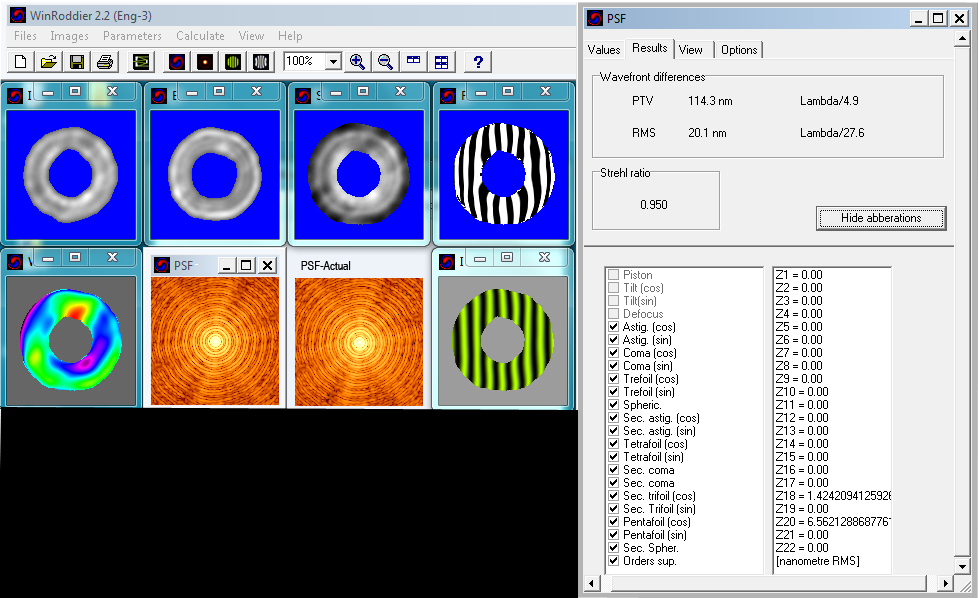
|
| RED: The glass is slightly undercorrected in the Red bandwidth, but still with a very good Strehl value of 0.948, which corresponds to a P-V wavefront error of slightly worse than 1/8th wave. The undercorrection in Red will tend to correct itself slightly as the glass temp cools and the glass reaches thermal equilibrium with the outside air. 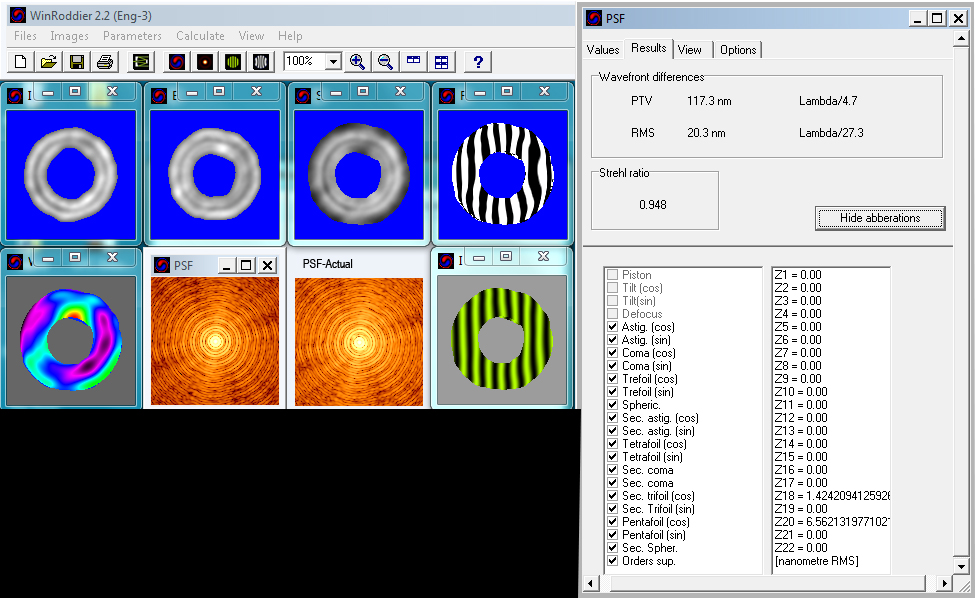
|
| BLUE: The scope was the worst corrected in Blue, but still with a good Strehl of 0.923. The optics are the most overcorrected in the Blue wavelengths. This overcorrection in Blue will be the primary weakness in the OTA's performance because it will not correct itself as the glass cools further and may even get slightly worse. But this problem will go mostly unnoticed for visual work since the human eye is relatively insensitive to the far-Blue bandwidth. It could be a factor though for CCD imaging and could hurt sharp star focus slightly, especially with one-shot color CCD cameras and color DSLR's. But the effects of it should be very minor for photography overall, especially for mono cameras where refocusing is done with each color filter change. The scope overall has good glass figure and should be a very good performer for both visual astronomy and CCD imaging. 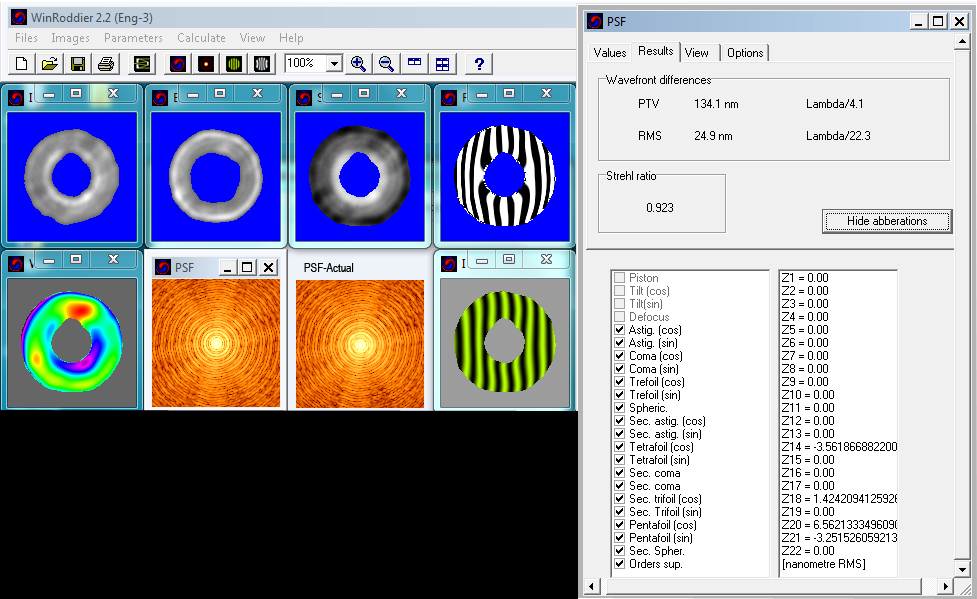
|
| POLYCHROMATIC
(entire Red, Green, and Blue wavelength data present in test images): As expected, due to the undercorrection in Red and overcorrection in Blue, the full-color Strehl is adversely affected compared to the Green wavelengths, but the OTA still tests out to a very good poly-Strehl of 0.946. In real-life use this telescope exhibits very good performance as a visual planetary and deep-sky instrument once it has reached thermal equilibrium, with nicely sharp focus and very good resolution of low-contrast planetary details. Despite the slight overcorrection noted in the Roddier testing, the overall optical correction over the entire color spectrum is still very good and the performance of the telescope verifies this. 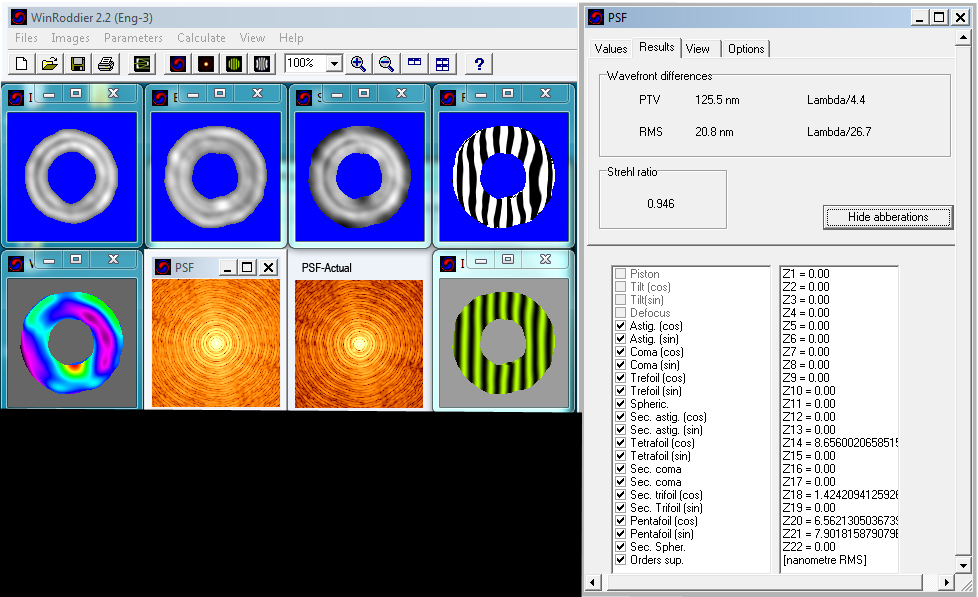 |
IV. Zernike Polynomials:
In this section, we examine the optical
alignment, astigmatism, collimation, and spherochromatic aberration of the
optics. The star used for the test (Scheat) was at a sky altitude of more than
70 degrees to help insure least possible interference in the results from
atmospheric effects and blue extinction. Green was used as the reference
bandwidth for these Zernike comparisons.
Strehl
with all optical figure and alignment defects included: 0.950
Strehl, or a very good result of
1/8th wave.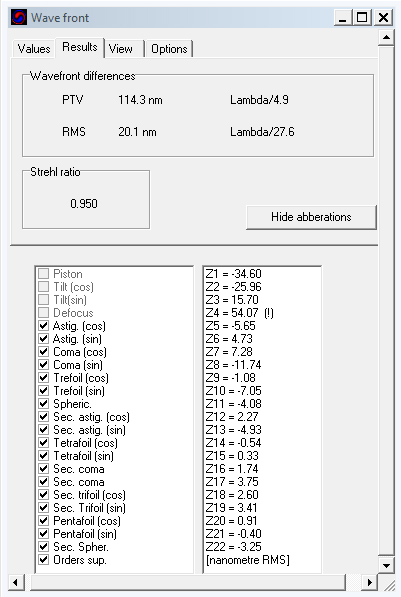 Overall, the glass quality on this unit is very good. Most of the wavefront error is likely due to atmospheric seeing, tip-tilt error from mirror flop, residual temperature flux in the mirror, and some slight mis-collimation of the telescope as seen in the full results above. This mis-collimation is end-user correctable. |
Strehl
with Coma removed from the measurements: 0.972 Strehl,
or an outstanding 1/10th wave.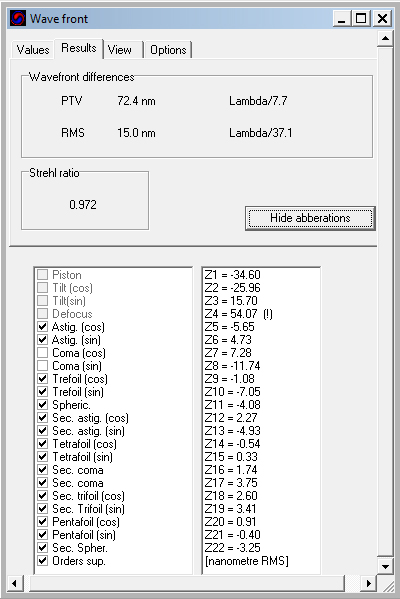 This result indicates the telescope still has a slight mis-collimation. In the PSF views above, this mis-collimation can be seen toward the 7 o'clock position. I highly recommend MetaGuide software as a very effective tool to achieve perfect collimation when atmospheric seeing is good. Most of the coma noted above can be reversed with a dead-on collimation in good seeing using MetaGuide. |
Strehl
with Astigmatism removed from the calculations: An excellent 0.955 Strehl,
or 1/8th wave.
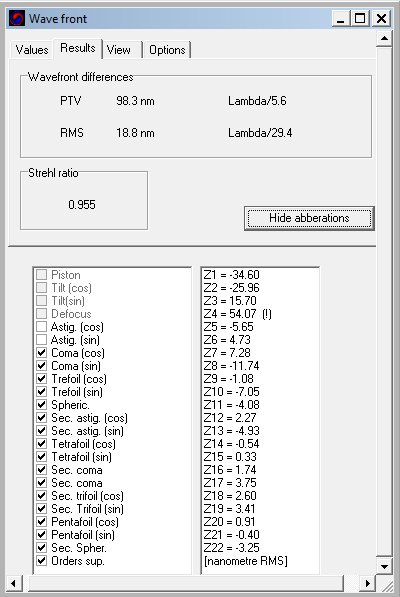 Astigmatism is very low on this unit and is likely due to slight tip-tilt error of primary mirror in relation to the secondary mirror. This error could be compensated for by basic collimation, but still be present in the wavefront analysis. Astigmatism could be caused by the typical SCT primary mirror "flop" causing some tip/tilt error in the primary mirror. Some slight astigmatism may be coming from the glass figure as well, or from residual temperature imbalance in the glass surface. |
| Strehl
with Spherical Aberration removed: 0.951 Strehl, or 1/8th wave. 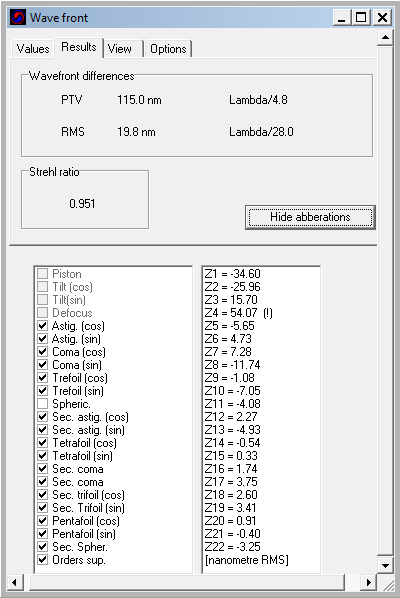 The telescope shows very low amounts of SA, indicating very good glass figure and that corrector glass positional accuracy has been achieved with the re-positioning work. Polychromatic SA is only slightly worse on this sample due to the slightly overcorrected Green and Blue wavelengths. Polychromatic Strehl on this OTA is 0.946, which is still excellent for full-color results. |
Test
image of Jupiter through Celestron CPC-DeluxeHD-1100 taken 12-17-2011 @
0412 UT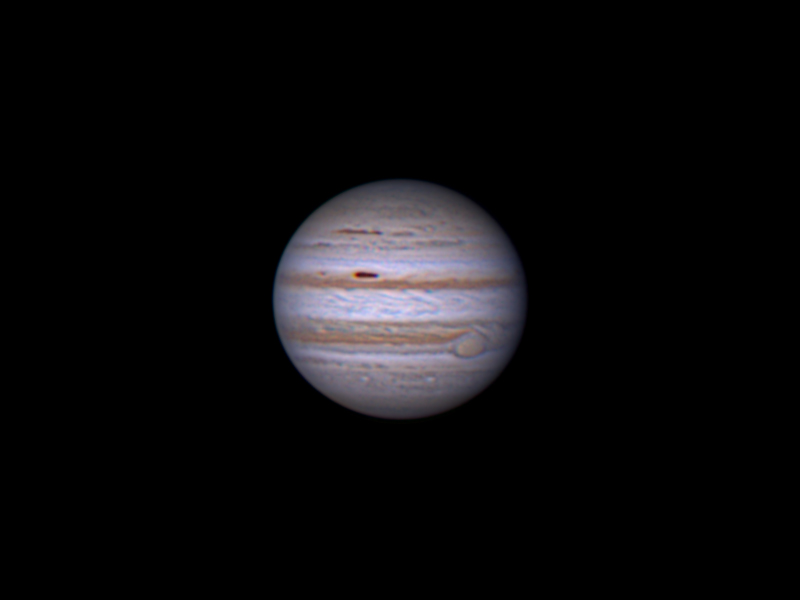 Camera: Point Grey Imaging Flea-3 FL3-U3-32S2M/C-CS mono webcam, FlyCap-2 capture software, Starlight X-Press filter wheel and Astronomik RGB filters. Stacking with AVI-Stack2, Registax Ver. 6 wavelets, Adobe Photoshop CS2 post-processing. 1000 exposures each with Red, Green, and Blue filters @ 640 x 480 frame size. 2.5 micron camera pixel size for a resolution of 0.18 arc-sec per pixel. |
|
V. Conclusions:
Roddier/Optical Analysis
Summary:
Ater
30 minutes of front-fan cooling, this CPC Deluxe EdgeHD-1100 tested out as
excellent with a Strehl value of 0.950, as measured
mid-bandwidth in the Green (approximately 550 nm wavelength), after
repositioning the corrector to the optimal position. This
corresponds to a wavefront error of approximately 1/8th wave glass accuracy with
the central obstruction effects not included in the calculations. The RMS result of Lambda/27.6 indicates a very smooth glass
surface with excellent glass figuring and polishing techniques used during manufacture. The
PTV result of Lambda/4.9 indicates the single worst glass-figure error is still
well below diffraction-limited and will not significantly affect the overall performance of the
telescope.
t
This
OTA shows low levels of spherochromatic aberration, which indicates the
front corrector plate is of excellent quality and has now been repositioned accurately
for maximum performance. The telescope is very slightly overcorrected in the Green wavelengths,
even more overcorrected
in the Blue wavelengths, and slightly undercorrected in the Red wavelengths.
The overcorrection in Green and Blue will be the primary factor that hurts the telescope's performance, but it is slight enough that it should go unnoticed for visual work. The undercorrection in the Red wavelengths will self-correct slightly as the glass continues to cool to equilibrium with the outside air temperature. But the glass will not correct in the Green or Blue wavelengths, and may get slightly worse as glass cooling continues though the night. This could cause a softer focus on extremely cold nights, although this effect has not been noticed so far in use at ambient temps down to 38 degrees F.
The overcorrection will be more noticeable however for imaging, especially from color one-shot cameras where one focus must work across the entire visible color spectrum. This condition can be helped by using a monochromatic camera and separate filters for the Red, Blue, and Green wavelengths, with a refocus of the telescope upon each filter. With an f/10 telescope such as this one, the critical focus zone is so deep it is likely that a refocus for each filter would not be necessary during on-axis planetary webcamming. For long-exposure deep-sky imaging, a refocus periodically due to temperature change would still likely be needed with an aluminum-wall OTA like this.
There is some slight residual coma seen in the test results that is mostly due to a slight mis-collimation condition still existing. Some of the coma could also be due to tip/tilt error caused by primary mirror flop. In this design, even with the factory mirror-locking system in use, the flop error is only cut approximately in half (as measured in earlier testing using CCDI software to analyze the mirror flop). It is impossible with this focusing mechanism and design to cut a moving mirror's flop error all the way to zero.
The visual testing so far has confirmed the Roddier results, with the telescope showing very good focus sharpness and resolution of fine contrast and detail on planetary visual observations when the OTA has been force-cooled to ambient temp and atmospheric seeing is good.
VI. Thermal Analysis:
**EFFECTS
OF FORCED-FAN COOLING AND INTERNAL OTA INSULATION WITH FELT FLOCKING**:
The initial front forced fan cooling does cause a significant
and consistent improvement in image stability as observed on repeated tests
using a webcam with in and out-focused star patterns. Initial testing of
this OTA has indicated that the internal flocking does seem to keep the
OTA more thermally stable and produce better image stabilization for longer
periods of time than with no flocking at all. However, further evaluation
is needed to verify this effect consistently and determine how large the
beneficial effects are. The future addition of continuously-on *rear* fans may
keep the OTA more stable for even longer periods of time after use of the
initial front-fan cooling system. This will be
tested as soon as the fans are available.
A final note about Celestron's claims that removing the secondary mirror assembly from the Fastar cell and reinserting it does not affect collimation: analysis of star-test patterns after several removal/reinsertion cycles did verify that on this OTA, their claim is true. I could not find any variation in collimation over several test cycles. So this makes front-end forced fan cooling much more feasible as a way to bring the OTA to proper equilibrium prior to observing. One must be extremely careful though in removing and reinserting the secondary assembly. It is very easy to have an accident with the assembly and drop it, especially in the dark or with cold fingers handling the assembly. So this factor should be carefully considered.
In my opinion it is very clear that this OTA can be brought to an acceptable level of thermal equilibrium easier and faster for serious planetary observations by using some type of forced cooling solution combined with enhanced aluminum OTA surface insulation. For those not wanting to disassemble the OTA to flock it internally, wrapping the outside of the OTA with some type of insulating material like lightweight foam would still help it thermally. While the telescope is usable for deep-sky observations without any modifications, my experiences with repeated testing of this OTA clearly indicate that it can be improved as a serious planetary instrument with forced cooling and tube insulating materials.
Also, **SEE DISCLAIMER BELOW**.
VII. A note about the
Roddier software used to measure Strehl in these tests:
The Roddier software does an analysis of the *glass quality*, not the final
wavefront quality. It does *not* include the central obstruction effects in
the final Strehl ratios it calculates from the test images. For a compound
mirror-obstructed telescope, the true wavefront Strehl at focal point can be
calculated using this formula (from
the book Suitor's "Star Testing Astronomical Telescopes":
Corrected Strehl Ratio = (Telescope’s measured Strehl Ratio) x (1-c^2)^2
c = central obstruction percentage of telescope’s primary mirror aperture by secondary mirror housing
For example, the Strehl value for this OTA's final wavefront accuracy once central obstruction effects are calculated is approximately 0.74, which is between 1/3rd and 1/4th wave (1/4th wave is diffraction-limited). If the optics were a near-perfect 0.99 Strehl, due to the 34% central obstruction of this OTA, the real wavefront Strehl at focal point would still only be 0.78 Strehl, or slightly worse than diffraction-limited. So this sample is only about 1/12th wave below the theoretical maximum optical performance attainable, which is a very good result for a telescope of this design and central obstruction size. This is verified with the actual visual and webcam performance of the OTA which is very good once the telescope is brought to thermal equilibrium and in the presence of good atmospheric seeing.
***DISCLAIMER*** I am not responsible for any damage you do to your telescope from attempting to make the modifications described here. If you decide to modify your own telescope, you do so at your OWN risk to the OTA and the factory warranty. Also, it is important to keep in mind that no two telescopes, even of the same model, are exactly the same in build or performance, especially mass-produced SCT's like the instrument described here. So your test results might vary widely from my results. Likewise, one's ability to disassemble, reassemble, and re-adjust the OTA to maximum performance will vary from user to user. Therefore, I make no claims or guarantees that your telescope's performance will be improved by making any of the modifications to it that are described here.
Wade Van Arsdale
November 7th, 2011
Little Rock, AR., USA